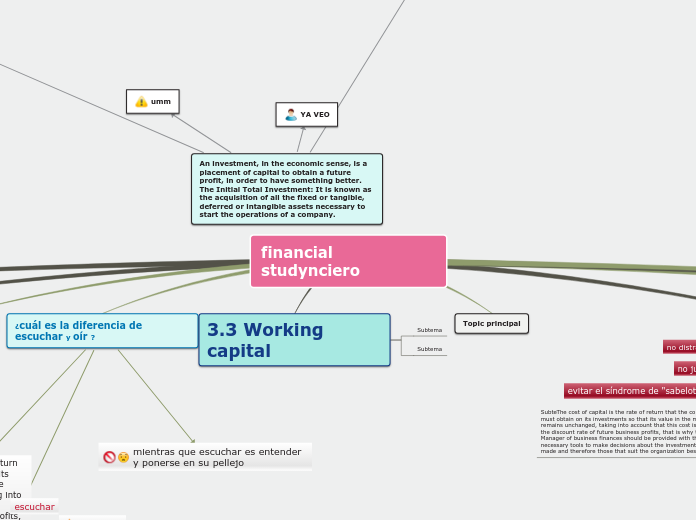financial studynciero
3.1 Objetiv
The cost of capital is the rate of return that the company must obtain on its investments so that its value in the market remains unchanged, taking into account that this cost is also the discount rate of future business profits, that is why the Manager of business finances should be provided with the necessary tools to make decisions about the investments to be made and therefore those that suit the organization best.
Subtema
3.2 Determination of costs
comunicación no verbal(gestos)
Subtema
comunicación verbal (tono de voz)
The cost of capital is the rate of return that the company must obtain on its investments so that its value in the market remains unchanged, taking into account that this cost is also the discount rate of future business profits, that is why the Manager of business finances should be provided with the necessary tools to make decisions about the investments to be made and therefore those that suit the organization best.
Topic principal
¿cuál es la diferencia de escuchar y oír ?
The cost of capital is the rate of return that the company must obtain on its investments so that its value in the market remains unchanged, taking into account that this cost is also the discount rate of future business profits, that is why the Manager of business finances should be provided with the necessary tools to make decisions about the investments to be made and therefore those that suit the organization best. de sonido
mientras que escuchar es entender y ponerse en su pellejo
ejemplo: la escucha activa(saber escuchar)
esperar a que termine de contar su situacion
escuchar
entender
3.3 Working capital
Subtema
Subtema
Topic principal
3.4 Total Initial Investmentl
Subtema
elementos a evitar en la escucha activa
no distraerse
no juzgar
evitar el síndrome de "sabelotodo"
SubteThe cost of capital is the rate of return that the company must obtain on its investments so that its value in the market remains unchanged, taking into account that this cost is also the discount rate of future business profits, that is why the Manager of business finances should be provided with the necessary tools to make decisions about the investments to be made and therefore those that suit the organization best.
Subtema
Topic principal
3.5 Cost of capital
Subtema
3.6 Financiamiento
Los préstamos pueden provenir de empresas o personas naturales, o por la vía más tradicional, que es a través de créditos bancarios.
Financiamiento a largo plazo: el plazo para cancelar es mayor a un año, o no existe una obligación como tal de devolver el dinero. Un ejemplo de esta clase de financiamiento se realiza a partir de fondos de parientes o amigos.
Financiamiento interno: se obtiene de recursos disponibles de la empresa. Ej. Amortizaciones, fondos de reserva, etc.
Financiamiento externo: provienen de personas que no pertenecen a la empresa. ej.: préstamos bancarios.
The cost of capital is the rate of return that the company must obtain on its investments so that its value in the market remains unchanged, taking into account that this cost is also the discount rate of future business profits, that is why the Manager of business finances should be provided with the necessary tools to make decisions about the investments to be made and therefore those that suit the organization best.
